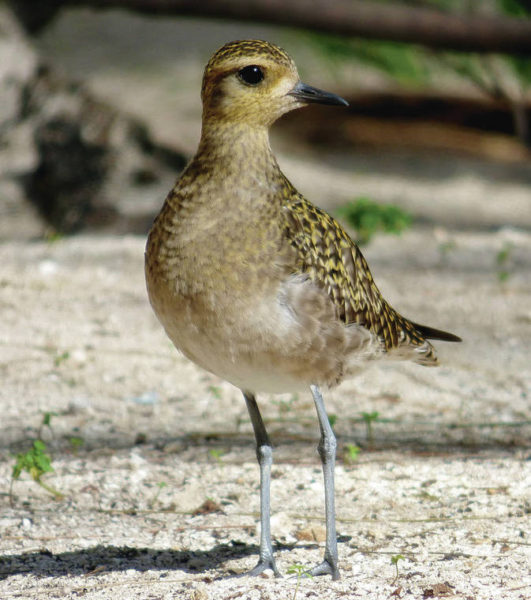Published in the Ocean Watch column, Honolulu Star-Advertiser © Susan Scott
August 3, 2019
My kolea is back! Well, mine hasn’t arrived yet, but that’s the sort of subject headings I’ve been seeing in my July emails.
Reader Paul sent me the first plover sighting at Paiko Lagoon, including photos of the bird on its last day there, May 28. The same bird appeared on a patch of Paiko grass on July 11. Without an ID band on the bird’s leg, it’s impossible to tell for sure it’s the same bird, but it’s extremely likely.
Once a Pacific golden plover finds a good foraging site for the winter, the bird usually sticks to it, returning there year after year. If another plover lands there, watch for a brawl. These delicate 4-ounce birds that we Hawaii residents so love can turn into little thugs when other birds, including mynahs, have the nerve to trespass.
 This kolea shows the species’ typical fall and winter colors of both
This kolea shows the species’ typical fall and winter colors of both
males and females. Come spring, the birds lose these feathers and
grow new ones that show the two sexes’ distinctive breeding colors.
Courtesy Luke Halpin
I wondered whether something bad happened to the early bird’s chicks, such as a summer storm or a predator attack. In addition to foxes on the Alaskan tundra, parent plovers have to protect their chicks from gulls, falcons and jaegers (pronounced YAY-gur, a seabird species that nests inland). Also, migrating caribou sometimes trample nests.
More kolea emails soon followed, also announcing early returns. On July 16 plover fans Chery and Brian Allen wrote that they saw three kolea in Mililani Mauka Community Park. Six days later, July 22, Ewa Beach resident Bruce Carlson wrote about spotting four plovers on a neighborhood rooftop.
Other readers saw July plovers in Kahala, Hawaii Kai and Punchbowl. Another kolea returned to Dennis Ida’s Hilo backyard “looking a little on the thin side … understandably.”
Usually, the birds, and emails about kolea homecomings, arrive in August. In the 15 or so years that I’ve been corresponding with Hawaii residents about our kolea, I’ve never heard of so many returns in July.
We plover lovers are all wondering about the effects of climate change on these migratory shorebirds, especially after Anchorage, Alaska’s record 90-degree heat this summer. I asked kolea expert Wally Johnson what he thought of these early returns.
Wally wrote, “Thanks for the arrival info — interesting. This is probably not an unusual pattern. Early birds might be either failed breeders or actually successful ones! If the latter, they’re apt to be mostly females as females often depart breeding grounds before males.”
Because feather molting starts when plover parents are sitting on their eggs, it’s not possible to tell whether our July birds are males or females. Nor do we know how the warm weather affected this year’s chick raising, since the birds nest in remote tundra areas uninhabited by humans.
But we now have a record of at least a dozen kolea arriving in July this year. Thank you, readers, for helping keep track of our remarkable shorebirds. “My kolea is back!” is one of my favorite email subjects.